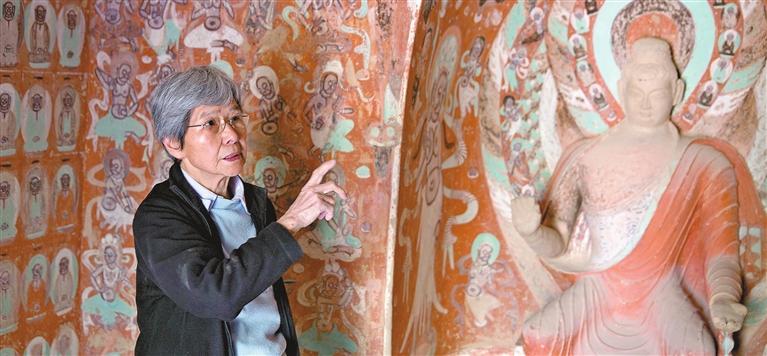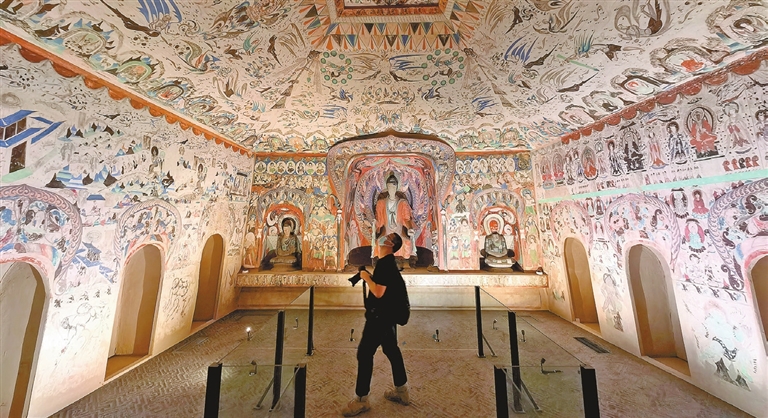

AN asteroid has been named after Chinese archaeologist Fan Jinshi in recognition of her contribution to the protection, study, and promotion of the Mogao Grottoes, a UNESCO World Heritage Site in Dunhuang in Northwest China’s Gansu Province. The asteroid coded 381323 was discovered by astronomers from the Purple Mountain Observatory under the Chinese Academy of Sciences, and its naming was approved by the International Astronomical Union. The naming was announced at a symposium held July 10 to commemorate Fan’s 60 years of dedicated efforts to the cultural relics protection in Dunhuang. Fan, 85, graduated with a major in archaeology from the History Department of Peking University. She started to work in Dunhuang in 1963 and made it a lifelong career to protect and study the cultural relics in the Mogao Grottoes. The news has been widely cheered on Chinese social media. The celestial honor was awarded to Fan in recognition of her contribution to the archaeological survey and conservation of Chinese grottoes, including the construction of “Digital Dunhuang,” according to a document issued by the International Astronomical Union. The “Digital Dunhuang” project was put forward in the late 1980s by Fan, then executive deputy dean of the Dunhuang Academy, in the hope of introducing the digital protection of this cultural heritage and preserving the associated data in high fidelity. By the end of 2022, the Dunhuang Academy had finished compiling the digital data collection on 278 caves, image processing for 164, and the 3D reconstruction of 145 painted sculptures and seven ruins, while delivering a panoramic tour program for 162 caves. With the help of ever-advancing digital technology, the project has also facilitated virtual access to the treasures for millions of people, without the need to open and access the actual caves. In 2022, the academy’s various online platforms recorded about 400 million visits from 120 countries and regions, said Du Juan, deputy director of the media center of Dunhuang Academy. Over the years, the institute has continued to explore various modes of cultural protection and promotion, taking advantage of the “Digital Dunhuang” project outcomes. In 2008, an exhibition featuring a high-fidelity reproduction of a famous mural in Cave 61 from the Mogao Grottoes was presented in Beijing. The replica was based on the digital data of a large mural of more than 40 square meters, which took researchers three months to create, from taking pictures to splicing them in a perfect manner. Digital images from the project were used to create an immersive 8K high-resolution movie about the grottoes, and in 2014, this was shown for the first time to visitors on a domed screen in the digital display center of Dunhuang. An online platform was launched in 2016, sharing high-definition images and panoramic views of 30 classic caves from the Mogao Grottoes with a global audience. In 2020, a mini app of the site was launched on WeChat, giving travelers convenient access to virtual tours and information at their fingertips, registering more than 200 million visits to date. In 2022, a blockchain-based digital resource-sharing platform went online, making available more than 6,500 archived high-definition digital images showing murals and manuscripts from the Mogao Grottoes and other grotto sites in Dunhuang. Despite the digitization project, which has improved the efficiency and accuracy in the cultural protection work, the monitoring and operation of the machines on site requires human labor and wisdom. Su Bomin, dean of Dunhuang Academy, said that the digitalization project has covered only about half of the caves so far, adding that data collection in the caves is hard work. The interior is gloomy and cold, with the daily high temperatures below 20 degrees Celsius even in summer, and data-collecting staff need to wear winter coats. Su said the institute will continue to improve sci-tech innovation and complete the digital archives for each cave, mural and sculpture. (Xinhua) | 
